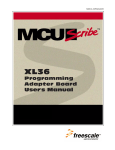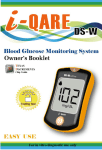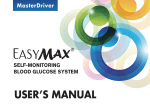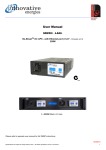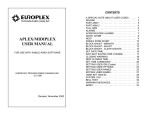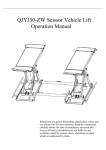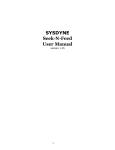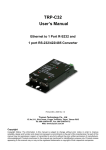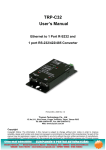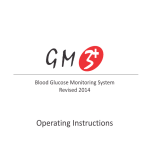Download Owner`s Booklet - Alliance International Co.,Ltd
Transcript
Dear i-QARE Blood Glucose Monitoring System Owner, Thank you for choosing i-QARE Glucose Monitoring System. The i-QARE Blood Glucose Monitoring System is easy, comfortable, and convenient to operate; also it helps you monitor blood sugar every day. This Owner’s Booklet will help you understand your i-QARE Blood Glucose Monitoring System. It also provides you with services, tools, and information, helping you to manage your monitoring system and blood sugar. To start testing quickly, you can also refer to the Quick Start Guide. If you have any questions, please contact Alliance International Co., Ltd. Customer Service Center toll-free at 1-866-400-3336 or visit www.alliance-intl.com.tw. Assistance is available 24 hours a day, 7 days a week. You can also contact your local agent for assistance. Again, thanks for choosing i-QARE Blood Glucose Monitoring System. INTRODUCTION Welcome to use i-QARE Blood Glucose Monitoring System. i-QARE Blood Glucose Meter utilizes the latest amperometric biosensor technology to measure blood glucose level. In order to keep your meter in good working condition, please follow the correct operation procedures in the Owner’s Booklet. Read this Owner’s Booklet carefully and completely before testing your blood glucose. To verify the accuracy of any glucose meter or test strip, the control solution can be purchased from your local distributor. INDICATION FOR USE The i-QARE DS-A Blood Glucose Monitoring System is used with the i-QARE DS-A Draw-In Blood Glucose Test Strips and 2-level Controls for the measurement of glucose in whole blood. Testing is done outside the body (in vitro diagnostic use). It is indicated for use at home (over-the-counter [OTC]) by person with diabetes, or in clinical setting by health care professionals, as an aid to monitor the effectiveness of diabetes control. It is not intended for the diagnosis of or screening for diabetes mellitus, and is not intended for use on neonates. The frequent monitoring of blood glucose is an adjunct to the care of persons with diabetes. WARRANTY 5-Year Warranty Alliance International Co., Ltd. warrants to the original purchaser of the meter that your i-QARE Blood Glucose Meter will be free from defects in materials and workmanship for 5 years from the date of purchase. If the meter does not work properly because of the defect in material or workmanship during this 5-year period, Alliance International Co., Ltd. will repair it or replace it with a new i-QARE Blood Glucose Meter. The warranty of the repaired or replacement meter will expire on the date of the original warranty expiration or 90 days after the shipment of a replacement meter, whichever period is longer. This warranty applies only to the original purchaser of the meter. This warranty does not apply to the performance of a Glucose Meter that has been damaged by accident or has been altered, misused, tampered with, or abused in any way. Alliance International Co., Ltd. will handle meters that show damage or abuse according to its Non-Warranty Service Policy, described below. In no event shall Alliance International Co., Ltd. be liable to the purchaser or any other person for any incidental, consequential, or punitive damages arising from or in any ways connect with the purchase, the operation of the glucose meter, or its parts. Non-Warranty Service Policy The i-QARE Blood Glucose Meter Non-Warranty Service Policy applies to meters where the above warranty has not become effective, has become inapplicable, or has expired. Alliance International Co., Ltd. will repair or replace at its option meters returned to it for a service charge. Replacement will be the same series or similar product. Replacement or repaired meter will be warranted for a period of 90 days from the shipment under a limited warranty providing for replacement of parts and labor at no charge. Warranty and Service Instructions All requests for return of the i-QARE Blood Glucose Meter under the above Warranty or Non-Warranty Service Policy must be made to the Customer Service Center by calling 1-866-400-3336 (Alliance International Co., Ltd.) or local distributor. Customer experiencing difficulties of operating meter should review troubleshooting or Error Message of this manual. For more information or inquiries, please contact Alliance International Co., Ltd. or local distributor. Be sure to fill out your warranty form and return it with your i-QARE Blood Glucose Meter to Alliance International Co., Ltd. or the local distributor. Alliance International Co., Ltd. Customer Service: No. 54 Ying-Tao Rd., Yingge Dist. New Taipei City 239, Taiwan Customer Service Line: 1-866-400-3336 (Our service is available 24 hours a day, 7 days a week) E-mail: [email protected] CONTENT Contents Introduction & Indication For Use 2 Warranty 3 Contents 6 Standard Kit Contents, Supplies, and Accessories 8 Specification of i-QARE Blood Glucose Meter 9 Specification of i-QARE Draw-In Test Strip 11 Chapter 1: Understanding Your New System Introduction of i-QARE Draw-In Test Strip Symbols Introduction of the LCD Screen Connecting (or changing) the Battery Setting Year, Time, and Date Coding the Meter 13 15 16 17 18 19 Chapter 2 Control Testing Control Solution Verifying Strip Accuracy Using Control Solution Notes 20 20 21 22 Chapter 3 Testing Your Blood Glucose Running a Blood Glucose Test Expected Blood Glucose Value 23 25 28 Chapter 4: Using Your Meter Memory 30 Chapter 5: Care, Cleaning and Maintenance Blood Glucose Meter Lancing device Battery Meter Operational Status Checking Suggestions 32 32 32 33 33 34 Chapter 6: 35 Safety and Disposal Chapter 7: Screen Message and Troubleshooting Message Description and Proceeding Solution Troubleshooting 36 36 40 Standard Kit Contents, Supplies, and Accessories Standard Kit of i-QARE Blood Glucose Meter 1. i-QARE Blood Glucose Meter x 1 2. CR2032 3V Battery x 1 3. Lancing Device x 1 4. Lancet x 10 5. CODE CARD x 1 6. Draw-In Glucose Test Strip x 10 7. Wallet x 1 8. User’s Manual x 1 9. Quick Reference Guide x 1 10. Diary for Self-Monitoring x 1 11. Control Solution (Normal) x 1 Supplies and Accessories (Need to be purchased separately) 1. 2. 3. 4. 5. Draw-In Glucose Test Strip 50 pcs (25/2vials) Lancing device Lancets Battery (CR2032 3V) Control Solution (2 levels - Normal and High) 2x2ml Note The above supplies and accessories are available in Alliance International Co., Ltd. or your local distributor. Specification of i-QARE Blood Glucose Meter 1. Dimensions: 94.5mm x 56mm x 27.5mm 2. Weight: 56g (with battery) 3. Power Source: CR2032 3V lithium coin battery x 1 4. Battery Life: about 500 times or last 10 months without using 5. Display: Large LCD 6. Memory: 360 results with time and date 7. Automatic power-on: Electrode inserting detection 8. Sample size: 1μL 9. Measuring time: 6 seconds 10. Sleep Mode: Power consumption less than 20uA 11. Automatic power off: After 1 minute without action 12. Temperature warning function 13. Operation Condition: 14℃- 40℃(57.2℉ - 104℉) 14. Storage/Transportation Condition: 4℃-32℃ (39.3℉- 89.6℉), < 95% R.H. 15. Altitude Limit: under 2610 meters (8562 ft.) 16. Measurement Unit: mg/dL or mmol/L Applied Standards This product conforms to the provisions of the FDA 510(K) and EC directive IVDD (98/79/EC). The following standards apply to the design and/or manufacturing of the product: IEC 60601-1 Medical electrical equipment Part 1: General requirement for safety IEC60601-1-2 Medical electrical equipment Part 2: Collateral standard: Electromagnetic compatibility-requirements and test IEC 61010-1 Safety requirements for electrical equipment for measurement, control and laboratory use Part 1: General requirement Specification of i-QARE Draw-In Test Strip 1. Strip Size: 35mm x 7mm x 0.35mm 2. Required Blood Sample: 1µL 3. Hematocrit: 30% - 55% 4. Sample Type: Fresh capillary whole blood 5. Test Range: 20 - 600 mg/dL 6. Operation Condition: 14℃- 40℃ (57.2℉ - 104℉) 7. Validity: Can be used within 90 days after opening or within 18 months after the production date 8. Unit of Packaging: 25 strips x 2 vials/box 9. Storage/Transportation Condition: 4℃- 32℃ (39.3℉ - 89.6℉), < 95% R.H. DO NOT REFRIGERATE Caution 1. Do not use any expired strips. 2. The strips are only used with i-QARE glucose meter. 3. Do not use any blood that has been preserved (e.g. by fluoride). 4. It is not recommended to test the blood level to newborn baby. 5. Taking high dose of vitamin C or having high level of uric acid may influence the blood glucose level, which may cause inaccurate test results. 6. Hematocrit above 55% may cause lower blood glucose level; hematocrit lower than 30% may cause higher blood glucose. 7. To protect the environment, dispose of the used lancets and strips in appropriate collection sites according to national or local regulations. Avoid other people touching the used lancets or test strips, which may cause cross infection. 8. Keep the test strip vial away from children; the cap is a choking hazard. In addition, the cap may contain drying agents which can harm the body if swallowed or inhaled. It may cause skin or eye irritation. Chapter 1: Understanding Your New System *Items may be sold separately. Test Strip SlotInsert test strip here DisplayShows blood glucose results, messages, and the results stored in memory. Function ButtonPress this button to enter to the Set Mode, move between fields (such as time, date, etc.) Power ButtonPress this button to enter or exit the Memory mode or change values in the Set mode. Front View Data SlotTransfer date from the meter to a computer. Side View Battery Cover Slide out cover to change battery Lanyard Hole Test Strip Vial Back View Code Card Cap with Comfort Dial Depth Selection Release Button Plunger Ejector Cover Protective Reaction Zone Test Strip Lancet Introduction of Draw-In Test Strip Reaction Zone Introduction Zone Application Zone 1. Reaction Zone This is located in the middle of the test strip. This area must be completely filled with blood sample. 2. Application Zone This is located on the top side of the reaction zone. When a drop of blood is applied to the reaction zone, it will be rapidly drawn in. 3. Introduction Zone On the test strip, black bars are located in the bottom area, and it must be inserted into the strip slot of the meter with the black bars facing up. Caution 1. Blood sample should not be applied to the Introduction Zone (black bars). 2. Avoid touching the reaction and application zones for long periods as moisture may affect the reaction and reading. Symbols Introduction of the LCD Screen Display Symbols The blood glucose meter displays symbols to guide you through the test and to assist you to determine whether the test strip and display function are ready or not. To check that all the display symbols are working, press the power button or insert the test strip electrodes into the meter. When a test strip or CODE CARD is inserted, the display will turn on automatically. Each time the meter is on, all the symbols should appear briefly. Connecting (or Changing) the battery 1. Use your thumb to slide the battery cover out of the meter. 2. Slightly pull back the buckle to loosen the battery. 3. Place a new battery in a 45 degree to the tray with the + side facing up. 4. Push the top of the battery until it is firmly positioned. Caution The battery symbol on the screen means the battery is low, and should be changed soon. Setting Year, Time, and Date Setting the time and date is important if you use meter’s memory or connect to your computer. 1. With meter off, press (Set button), the year will flash. 3. Press again, the month will flash. 2. Press (power button) to change the year, until the desired year is displayed. 4. Press to change the month, until the desired month is displayed. 5. Repeat step 3 and 4 to change day, hour, minute, and unit. 6. Press to finish set-up and the meter will turn off automatically. Coding the Meter 1. With the meter off, insert the code card into the test strip slot. Please make sure the number on the code card matches the code on your display. 2. When you insert a test strip (see Running a Blood Glucose Test), the meter will turn on automatically and show the strip code number. Please make sure the code number on the meter screen matches the code on the test strip vial. Same 3. Throw away the old code card. Caution 1. Each box of test strip contains one CODE CARD designed specially with one code number. REMEMBER to change the CODE CARD every time you open a new box of test strip. 2. DO NOT insert different brands or models of CODE CARD or strip, which cannot turn on and function the meter. 3. Chapter 2 Control Testing Blood Glucose Control Solution (2 Levels) To ensure that the glucose meter is operating correctly and obtaining accurate results, it is recommended to test with a control solution. At room temperature, Control Solution test results should fall within the expected range printed on the test strip vial label. If your values are outside of the range, repeat the quality control by using a new test strip. If the second result is still outside of the control range, please call the service line or national distributor. Accurate results also depend upon the meter being properly coded to match the code number printed on each test strip vial label. Use of controls for two levels is also recommended in the following conditions: For practice purpose: to the first-time users when using a new glucose meter or a new vial of test strips. 1. All levels of control solution should be run with each new lot of test strips. 2. Whenever the test strips are exposed to the temperatures above 40℃ (104℉) or below 14℃ (57.2℉). 3. After inappropriate operating the equipment. 4. When your blood glucose result appears doubtful. 5. When your diabetic therapy is changed. Caution Do not use expired control solution. The expiration date is printed on each container. Upon opening the control solution, the date of opening should be noted. The control solution can be used for 3 months after initial opening, and can be stored at room temperature. Verifying Strip Accuracy Using Control Solution Before measuring your blood glucose level, you will need the following materials: A. B. C. D. E. Your i-QARE Blood Glucose Meter Fresh i-QARE Draw-In Test Strip Fresh Control Solution CODE CARD Lancing device and Lancets 1. Place the vial of the test strip in an upright position. Take a new test strip from the vial and close the vial lid immediately. 2. Insert the test strip into the meter strip slot and open the Control Solution. . 3 3. Squeeze a drop of control solution on a clean plastic surface, and close the control solution vial. . 4 4. Apply the drop to the application zone of the test strip. The solution is automatically drawn in and an audible signal is heard for confirming that the test strip took in a sufficient quantity of control solution. 5. The measurement appears within 6 seconds. Compare it with the range printed on the strips vial. Note If the result of your measurement falls within the range shown on the strip vial, an accurate blood glucose reading is ensured. If the test result falls outside the range, the following may apply: A. The control solution is no longer fresh or the test strip is not sufficiently filled. B. Ensure the glucose meter is used under 14℃-40℃ (57.2℉-104℉), and the test strips and the control solution are stored under 4℃-32℃ (39.3℉-89.6℉), < 95% R.H. C. Ensure the blood sample fully fills the reaction zone of the test strip, see below: If the above situations occur, repeat the measurement at correct temperature, utilizing fresh control solutions or a new piece of test strip (See Warranty Policy). Chapter 3 Testing Your Blood Glucose Preparing lancing device to get blood sample 1. Twist and pull off the cap. 2. Insert a lancet firmly 1. Twist off the intoand the pull holder. cap. 3. Twist off the lancet’s protective cover. 4. Snap the cap back on and twist the cap back to the device. Plunger 5. Twist the cap to set the lancet depth. (Start at 2 to 3). For tougher skin, dial to a higher number. 6. Pull the plunger until it clicks. Set aside until later in the test. Caution 1. 2. 1. To reduce the risk of infection, NEVER share your lancet with anyone. When checking the blood glucose level from different users, remember to disinfect the lancet cap and the entire surface that has stained with blood after testing. It is NOT appropriate to disinfect and reuse the lancet. Please dispose the used strip and lancet safely and properly. Running a Blood Glucose Test Before running your first test, make sure you set up meter properly. 1. Use warm water to wash your hands and dry them. Then, massage your fingertips gently. It will be easier to get blood sample with less pain. 2. Take one test strip from the vial and close the vial cap rapidly and tightly. 3. Insert a test strip; make sure the code on the meter matches the code on the test strip vial. Notes 1. After taking out the test strip from the vial, close the cover of the vial rapidly. 2. If the temperature is lower than 14℃ or higher than 40℃, the LCD screen will display “E-t” message. 3. If the code number on the display does not match the code on the test strip vial, please contact Alliance International Co., Ltd. or your local distributor. 4. When you see the flashing blood drop, hold the lancing device against the side of your fingertip and press the release button. Release Button 5. Gently squeeze your finger to assist the flow of blood. 6. This helps you get a blood drop. Touch the drop to the tip of the yellow application zone of the test strip. Do not apply blood on top surface of test strip. When you hear a “beep” sound, you have enough blood in the test strip. 7. After finishing the test, please use the protective cap to cover the needle, eject the lancet, and discard it. Note 1. Correct Blood Application The strip has enough blood in the test strip. Ensure the blood application zone is fully filled, and then remove your fingertip from the test strip. Incorrect Blood Application The strip has insufficient blood in the strip which may result in an error message or inaccurate result. Please discard the strip and insert a new test strip to measure again. Expected Blood Glucose Level Expected blood glucose levels for people without diabetes (referenced from the American Diabetes Association Clinical Practice Recommendations 2004, Diabetes Care, Vol. 27, Supplement 1 P. S9) Time Range (mg/dL) Range (mmol/L) Fasting 70 to 110 3.9 to 6.1 Two hours after meals Less than 140 Less than 7.8 Note 1. If your blood glucose result is unusually high (over 300mg/dL), the user should check the quality control. If your blood glucose is under 50mg/dL, contact your healthcare provider immediately. 2. If your blood result appears doubtful, repeat the test procedure by using new test strips and running the quality control to ensure that the strip and meter are working properly. If the control results are within the ranges on the vials, retest your glucose level. 3. If you open a new vial of test strips, ensure the code on the vial matches the code on the meter. If the code does not match, calibrate with a new CODE CARD. Once the code number on the meter is displayed, insert the strip from the new vial into the meter. Understanding Your Test Result The Blood Glucose Value is variable and will be affected by different elements. For example: 1. 2. 3. 4. Measuring blood glucose level at different times in a day, Types of food you eat, Body condition, Insulin and medicines, etc. High Blood Glucose Value If the Blood Glucose Value is too high or you have symptoms such as thirst, pyuria, regurgitation, vomiting, dystopia, somnolence, belly ache, please consult with your physician immediately. Low Blood Glucose Value If the Blood Glucose Value is too low or you have the symptoms such as night sweat, cold to shake, palpitating, headache, dystopia, dizzy, tachycardia, tinnitus, paralysis of fingertip, please consult with your physician immediately. Unusual Test Results If your blood sugar result doesn’t match the way you feel, follow these steps: 1. Run a control test 2. Repeat a blood glucose test If your blood glucose results still don’t reflect the way you feel, call your doctor immediately. Chapter 4: Using Your Meter Memory Storing Test Result Your meter automatically stores up to 360 test results, and you can review them at any time. If you have set the time and date on the meter (see Setting Year, Time, and Date), that information is also stored and displayed with your test results. Moreover, the Healthy Life Meter can also check the average value of blood glucose results for the past 7, 14, 21, and 28 days. The i-QARE meter will first display 7, 14, 21, and 28 days average values, as follows: 1. With the meter off, press 2. Press to turn on the meter. to display the 7-day average. Example 3. Press again to display the 14-day average. By repeating this step, you can check the average values of 21 and 28 days. Example 4. Press to continue to recall each test result with date and time. The display will show the result number “01”first, and then Blood Glucose Result, Measuring Date, and Time. Repeat this step to check the following test results. 5. To quit the memory recall, keep pressing glucose meter. to turn off the Notes 1. Once the memory is full (360 sets), the latest result will cover the oldest one. Chapter 5: Caring, Cleaning and Maintenance Blood Glucose Meter Caring and Cleaning of Blood Glucose Meter is very easy. Follow the instructions below and it will make sure your meter works properly: 1. DO NOT disassemble the Blood Glucose Meter. If there is any problem, please contact the Distributor for assistance. 2. Please carry or hold the Blood Glucose Meter carefully to avoid extreme shock or accidental drop-down. 3. The Blood Glucose meter should work or be used under the temperature environment between 14℃ - 40℃ (57.2℉-104℉). 4. DO NOT expose the Blood Glucose Meter and Test Trip to extreme hot temperature, high humidity (Kitchen or bathroom), or direct sunlight. 5. DO NOT use abrasive cleaners and never submerge the body of the blood Glucose Meter in water or other liquids. For proper cleaning, use a soft, dry lint-free cloth to clean the body of the Meter and lancing device. Cleaning Your Lancing Device To clean your lancing device, use a mild dishwashing liquid and a soft cloth. DO NOT place the entire device under water. At least once a week, disinfect the cap after cleaning by placing it in 70% alcohol (isopropyl) for 10 minutes. Rinse with water and allow the cap to air-dry after disinfecting. Battery 1. 3V Lithium coin battery can support approximately 500 times of blood glucose test. When the battery needs to be changed, please use ONLY CR2032 3V Lithium coin battery or the same kind of 3V Lithium coin battery. 2. When the LCD screen display the symbol , please change the battery immediately in order to avoid wrong test results. 3. Steps of changing the battery, please refer to Connecting or Changing the Battery. 4. Changing the battery will not affect the test results in the memory. 5. After changing the battery, you will have to reset time and date. Please refer to Setting Year, Time, and Date. Meter Operational Status Checking 1. Insert CODE CARD firmly into the test strip slot, the code number will display on the screen. 2. After removing the CODE CARD, the upper-left side of display will show the symbol . This symbol means the function of the meter is fully operational. 3. If the display DOES NOT show the symbol , it means the blood glucose meter is DEFECTIVE, and may cause wrong test results. Please contact the Distributor. Suggestions: 1. Please carefully read this User’s Manual of Blood Glucose Meter and Test Strip. 2. DO NOT change the diabetic therapy without consulting your physician. 3. If the test result is extremely different from your usual test results, please contact your physician. 4. Please DO NOT expose the new test strips to the air for a long while. DO store the test strip in the vial. 5. The test strips and the control solution should be used before the expiry date and should be stored in the normal room temperature. Please DO NOT refrigerate it. 6. If the fresh blood sample has very high density of reducing substrate (Vitamins C, Uric Acid, etc.), it will affect the value of test result. 7. The hematocrit of the blood sample is higher than 55%, it will cause the value of the test result to be lower than the normal test result value. 8. During the blood glucose test, please ensure that the blood sample is fully filled all over the Blood Application Zone (yellow square area) of the test strip. Insufficient blood sample or blood sample flows over the test strip instead of drawing will cause incorrect test results. Chapter 6: Safety and Disposal Glucose Meter 1. Please avoid operating Glucose Meter near devices of generating potential electromagnetic interferences. 2. Do not dispose as household waste. Dispose according to local regulations. 3. Take out battery before disposing. 4. Please recycle if possible. Used strip, lancet and pads 1. Used strips, lancets, and alcohol pads may be infectious if users have been infected with contagious diseases. 2. It is important to treat the used materials as infectious or biologically hazardous wastes. 3. Do not dispose as household waste. Dispose according to local regulations. Battery 1. Before using, please ensure that the battery cover is closed. 2. Use only approved battery type, non-approved battery may cause damage. 3. Do not dispose as household waste. Dispose according to local regulations. 4. Do not dispose battery in fire. 5. Please recycle if possible. Caution When testing blood from multiple users, disinfect the lancing device and surfaces in contact with blood after each use. Dispose the test strips and lancets safely. Chapter 7: Screen Message and Troubleshooting Message Description and Proceeding Solution All the messages will be displayed by symbols or images on the display. However, when the incorrect operation cause the incorrect test results, the glucose meter will not display any messages or symbols for the incorrectness. If you still have questions, please contact your local Distributor. Message Description Proceeding Solution Every time after starting your glucose meter, please ensure all the symbols show on the display briefly. Please compare it with Symbols Introduction of the LCD Screen. If there are any symbols that do not display properly, it could cause incorrect test result. Please contact local distributor. After inserting the “CODE CARD” Chip, display shall show the code number and your measuring unit. Ensure the code number on the display and the CODE CARD are the same. Message Description Proceeding Solution After pressing the key, the Screen shall display the Code Number and the symbol of waiting for test strip to be inserted. Make sure the code number on the screen and on the label of test strip vial are the same. Insert the test strip and draw in the blood sample till you hear a beep sound and the test will start. After drawing the blood sample into the test strip, the 6-second countdown shall start. After the countdown is finished, the rest result will display on the screen. NONE Your blood glucose may be extremely low. If it is lower than 20mg/dL. Ensure the test strip has drawn in sufficient blood sample to the blood application zone and test again with new strip. If it is still displaying the “LO” symbol, please consult with your physician. Your blood glucose may be extremely high. If it is higher than 600mg/dL. Make a new test with new test strip again. If it is still displaying the “HI” symbol, please consult with your physician. Message Description The Test Result will be stored in the memory. Proceeding Solution After entering the Memory Mode, press Key to recall saved Blood Glucose Results with date and time. The memory can record the latest 360 Blood Glucose Results. Result for the past 7, 14, After entering the memory 21, and 28 days. mode, press key to see the average value of blood glucose result for the past 7, 14, 21, and 28days sequentially. If the temperature is extremely high or low during the operation of the glucose meter Move to an area between 14。C - 40。C (57.2℉ 104℉), wait 5 minutes and repeat the test. The test strip is used or damaged. Please DO NOT reuse the test strip. Please use a new strip to test again. Message Description Proceeding Solution The glucose meter does not insert the CODE CARD for coding. Please refer to Coding the Meter and the use of correct CODE CARD. The battery is out of power. Please change the battery to avoid incorrect test results or else the glucose meter cannot be operated. Troubleshooting After inserting the i-QARE DS-A Draw-In Blood Glucose Test Strip, if your Glucose Meter does not display any message or start the test, please check the following possible reasons and solutions. If you still cannot solve the problem, please call our help line at 1-866-400-3336. Reasons Solutions The battery is weak or no battery is installed. Change to a new battery or install a battery. The battery is installed in the wrong direction. Ensure that the plus (+) sign of the battery is facing upward. The test strip is inserted in wrong direction or is not inserted completely. Ensure to insert the introduction zone of the test strip firmly into the strip slot which is located on the top of the meter. Then insert the test strip to the end of strip slot. The glucose meter or the test strip is not working. The battery is weak or no battery is installed. After inserting the test strip and turning on the glucose meter, the glucose meter turns off automatically and the glucose meter does not operate for 1 minute. Remove the test strip and insert the strip in the strip slot again, wait until the blood application symbols are shown on the display, and draw in the blood sample for testing.












































